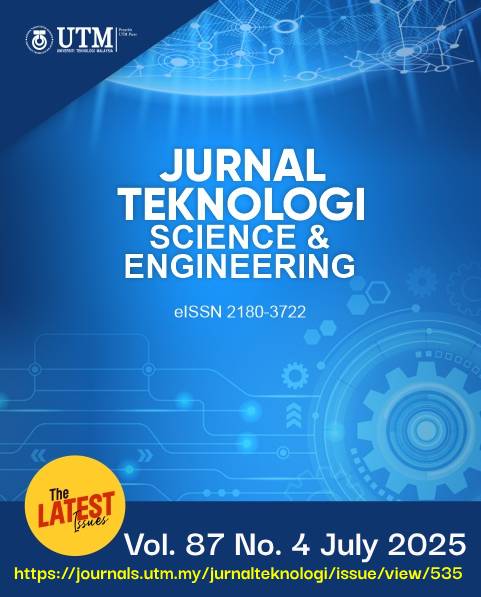VERIFICATION TESTING OF A WELL-MATCHED WIND TURBINE POWER GENERATION SYSTEM
DOI:
https://doi.org/10.11113/jurnalteknologi.v87.22893Keywords:
Wind turbine, generator, low wind Speed, rated power, verification testingAbstract
Due to Malaysia's typically low and fluctuating wind speeds, it is crucial to carefully select and match appropriate wind turbine generators to ensure efficient power production. However, the data provided by manufacturers for wind turbine generators often differs from actual operational performance. This study aims to develop a test rig and setup to characterize the generator constant. The verification testing involved validating a 1kW generator with a rated voltage of 48V and a rated RPM of 380 under both unloaded and loaded power systems. The results showed that the calculated generator constant (Kv) for the 1kW 48V generator was 4.56 rpm/V when the system was unloaded. When the system starts charging, using an Energy Storage Capacity (ESC) of 4.8kWh, the Kv value increased to 63.13 rpm/V. The maximum charging power (Pc) that could be generated under these conditions was 944W at 533 rpm. According to the results, at the generator's rated RPM of 380, the maximum charging power attainable is 608W. This test result contradicts the manufacturer's claim that at a rated RPM of 350, the power output is 1kW.
References
N. Masseran, A. M. Razali, K. Ibrahim, and W. Z. Wan Zin. 2012. Evaluating the Wind Speed Persistence for Several Wind Stations in Peninsular Malaysia. Energy. 37(1): 649–656. Doi: 10.1016/j.energy.2011.10.035.
A. Albani and M. Z. Ibrahim. 2017. Wind Energy Potential and Power Law Indexes Assessment for Selected Near-coastal Sites in Malaysia. Energies. 10(3). Doi: 10.3390/en10030307.
E. A. Kadir, M. T. Miskon, N. A. Rashid, and M. Y. Yunus. 2018. A Study of Vertical Wind Turbine for Application in Low Wind Speed Condition in UiTM Terengganu, Malaysia. J. Power Energy Eng. 06(08): 38–48. Doi: 10.4236/jpee.2018.68002.
J. H. Kao. 2016. Developing the Process in Matching a Wind Turbine System to Attain Optimal Performance. Adv. Mech. Eng. 8(11): 1–9. Doi: 10.1177/1687814016674697.
C. J. J. Labuschagne and M. J. Kamper. 2021. Wind Generator Impedance Matching in Small-Scale Passive Wind Energy Systems. IEEE Access. 9: 22558–22568. Doi: 10.1109/ACCESS.2021.3056226.
J. S. Artal-Sevil, R. Dufo, J. A. Dominguez, and J. L. Bernal-Agustin. 2018. Small Wind Turbines in Smart Grids. Transformation of Electrical Machines in Permanent Magnet Synchronous Generators. 2018 13th Int. Conf. Ecol. Veh. Renew. Energies, EVER 2018. 1–8. Doi: 10.1109/EVER.2018.8362404.
L. W. Ho. 2016. Wind Energy in Malaysia: Past, Present and Future. Renew. Sustain. Energy Rev. 53: 279–295. Doi: 10.1016/j.rser.2015.08.054.
Rajveer Mittal, K. S. Sandhu, and D. K. Jain. 2010. An Overview of Some Important Issues Related to Wind energy conversion system. Int. J. Environ. Sci. Dev. 1(4): 351–363. Doi: 10.7763/IJESD.2010.V1.69
J. H. J. Potgieter and M. J. Kamper. 2012. Design of New Concept Direct Grid-connected Slip-synchronous Permanent-magnet wind generator. IEEE Trans. Ind. Appl. 48(3): 913–922. Doi: 10.1109/TIA.2012.2191251.
W. Cao, Y. Xie, and Z. T. 2012. Wind Turbine Generator Technologies. Advances in Wind Power. InTech. Doi: 10.5772/51780.
R. Cardenas, R. Pena, S. Alepuz, and G. Asher. 2013. Overview of Control Systems for the Operation of DFIGs in wind Energy Applications. IEEE Trans. Ind. Electron. 60(7): 2776–2798. Doi: 10.1109/TIE.2013.2243372.
J. Pyrhönen, J. Nerg, P. Kurronen, J. Puranen, and M. Haavisto. 2010. Permanent Magnet Technology in Wind Power Generators. 19th Int. Conf. Electr. Mach. ICEM 2010. May 2017. Doi: 10.1109/ICELMACH.2010.5608312.
R. Syahputra, R. O. Wiyagi, and Sudarisman. 2017. Performance Analysis of a Wind Turbine with Permanent Magnet Synchronous Generator. J. Theor. Appl. Inf. Technol. 95(9): 1950–1957.
J. H. J. Potgieter, M. J. Kamper, and S. Member. 2015. Design Optimisation of Directly Grid-connected PM Machines for Wind Energy Applications. 9994(c): 1–10. Doi: 10.1109/TIA.2015.2394506.
R. H. Moncada, B. J. Pavez, F. F. Huenupan, G. M. Curilem, and R. A. Hunter. 2018. Permanent-magnet Machine Selection for Precise Matching with a Wind Turbine. Proc. - 2018 23rd Int. Conf. Electr. Mach. ICEM 2018. 926–933. Doi: 10.1109/ICELMACH.2018.8507001.
M. Nasir Uddin and N. Patel. 2016. Maximum Power Point Tracking Control of IPMSG Incorporating Loss Minimization and Speed Sensorless Schemes for Wind Energy System. IEEE Trans. Ind. Appl. 52(2): 1902–1912. Doi: 10.1109/TIA.2015.2510507.
Z. Cui, L. Song, and S. Li. 2017. Maximum Power Point Tracking Strategy for a New Wind Power System and Its Design Details. IEEE Trans. Energy Convers. 32(3): 1063–1071. Doi: 10.1109/TEC.2017.2694008.
H. Fathabadi. 2017. Novel Maximum Electrical and Mechanical Power Tracking Controllers for Wind Energy Conversion Systems. IEEE J. Emerg. Sel. Top. Power Electron. 5(4): 1739–1745. Doi: 10.1109/JESTPE.2017.2727978.
R. H. Moncada, R. A. Rodriguez, J. A. Tapia, and T. M. Jahns. 2009. Axial Flux Permanent-magnet Machine under Optimum Control Strategy for Wind Power Generation. 2009 IEEE Int. Electr. Mach. Drives Conf. IEMDC ’09. 1065–1071. Doi: 10.1109/IEMDC.2009.5075336.
Y. Parvini, A. Vahidi, and S. A. Fayazi. 2018. Heuristic Versus Optimal Charging of Supercapacitors, Lithium-Ion, and Lead-Acid Batteries: An Efficiency Point of View. IEEE Trans. Control Syst. Technol. 26(1): 167–180. Doi: 10.1109/TCST.2017.2665540.
Downloads
Published
Issue
Section
License
Copyright of articles that appear in Jurnal Teknologi belongs exclusively to Penerbit Universiti Teknologi Malaysia (Penerbit UTM Press). This copyright covers the rights to reproduce the article, including reprints, electronic reproductions, or any other reproductions of similar nature.
















